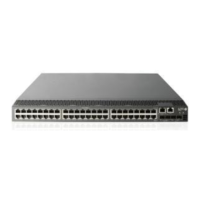
Do you have a question about the HP 5830 series and is the answer not in the manual?
Explains command syntax conventions, keywords, arguments, and how to access online help.
Describes the hierarchical structure of CLI views and how to navigate between them.
Covers entering commands, editing command lines, using tab completion, and abbreviations.
Details how to use command history and control CLI output for better readability.
Explains user privilege levels, command levels, and how they restrict command access.
Describes how users can switch between privilege levels without logging out.
Explains how to save the current running configuration to a file to persist across reboots.
Provides an overview of available login methods like console, Telnet, SSH, and Web interface.
Explains the role and assignment of user interfaces (AUX, VTY) for CLI logins.
Details the initial login process via the console port and authentication methods.
Explains how to log in via Telnet and configure authentication and control.
Describes how to log in via SSH, configure the server, and authentication methods.
Covers enabling and configuring HTTP and HTTPS logins via a web browser.
Details the steps for configuring SNMPv1, SNMPv2c, and SNMPv3 login settings.
Explains how to control Telnet logins using IP and MAC address-based ACLs.
Describes how to control Web logins using IP-based ACLs and log off users.
Covers using the device as an FTP client and server, including connection setup.
Details managing FTP connections, switching users, troubleshooting, and terminating connections.
Explains how to use the device as a TFTP client for file transfers.
Covers storage medium naming rules and file name formats.
Details operations for managing files (display, rename, copy, delete) and directories.
Covers managing storage media space, batch operations, and file system modes.
Explains configuration file types like startup and running configurations.
Covers saving running configurations, auto-update, and automatic backups.
Details configuring archive parameters, location, and automatic archiving.
Covers performing rollback, specifying startup files, and managing them.
Overview of methods: BootWare, System Software, Hotfixes, and ISSU.
Details the In-Service Software Upgrade process for continuous forwarding.
Covers ISSU overview, flowchart, and essential upgrade tasks.
Explains ISSU states, version rollback, and compatibility checks.
Covers configuring device name, system time, and airflow direction.
Details configuring exception handling methods and rebooting the device.
Explains how to schedule jobs using non-modular and modular methods.
Describes the workflow and process of automatic device configuration.
Explains how DHCP is used to obtain IP addresses and other configuration parameters.
Details how devices obtain configuration files from a TFTP server.
Describes the process of executing the obtained configuration file.
Provides information on how to contact HP for technical support.
Recommends product registration for updates and enhancements.
Lists resources like documents and websites for further information.
Explains conventions used for command syntax, keywords, and arguments.
Details conventions used for graphical user interface elements like buttons and menus.
Explains the meaning of symbols used for alerts (Warning, Caution, Note, Tip).